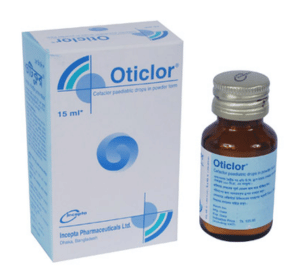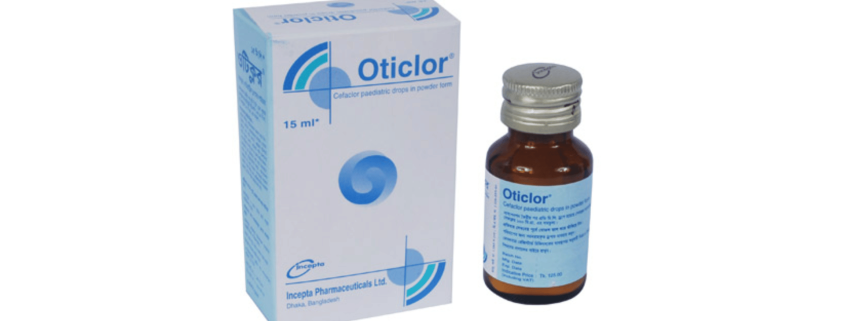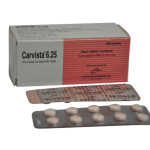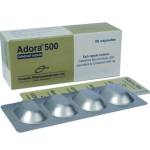Oticlor(Cefaclor)

Therapeutic Group: Anti Bacterial
Presentation
Oticlor 500 Capsule : Each capsule contains Cefaclor Monohydrate USP 524.46 mg equivalent to Cefaclor 500 mg.
Oticlor Dry suspension: After reconstitution, each 5 ml suspension contains Cefaclor Monohydrate USP 131.11 mg equivalent to Cefaclor 125 mg.
Oticlor Paediatric drops: After reconstitution, each ml drop contains Cefaclor Monohydrate USP 104.9 mg equivalent to Cefaclor 100 mg.
Description
Cefaclor, a second generation cephalosporin, demonstrates the bactericidal action by inhibiting cell wall synthesis. It is active against the following organisms In Vitro:
Aerobes, Gram-positive: Streptococcus pneumoniae, Streptococcus pyogenes (Group A beta-haemolytic streptococci) and Staphylococci.
Aerobes, Gram-negative: Moraxella catarrhalis, Haemophilus influenzae, Escherichia coli, Proteus mirabilis, Klebsiella sp.,Citobacter diversus and Neisseria gonorrhoeae.
Anaerobes: Propionibacteria acnes, Bacteroides sp. (excluding Bacteroides fragilis), Peptococci and Peptostreptococcus sp.
Indications
Oticlor is indicated in the treatment of the following infections:
Otitis media
Lower respiratory tract infections, including pneumonia, bronchitis and acute exacerbation of chronic bronchitis
Upper respiratory tract infections, including pharyngitis and tonsillitis
Urinary tract infections, including pyelonephritis and cystitis
Skin and soft tissue infections
Sinusitis
Dosage & Administration
Oticlor is administered orally.
Children: The usual recommended dosage for children is 20 mg/kg/day in divided doses every 8 hours. The dose of Oticlor suspension and paediatric drops for children is given in the following:
Age Oticlor suspension Oticlor Paediatric Drops
1 month – 1 year 2.5 ml t.i.d. 0.625 ml t.i.d
1 year – 5 year 5 ml t.i.d. 1.25 ml t.i.d
over 5 years 10 ml t.i.d 2.5 ml t.i.d
In more serious infections, such as otitis media, or those caused by less susceptible organisms, 40 mg/kg/day is recommended, with a maximum dosage of 1 gm/day. Safety and efficacy have not been established for use in infants aged less than 1 month.
Adults: The usual adult dose is 250 mg every 8 hours. For bronchitis, the dosage is 250 mg administered 3 times daily. A dosage of 250 mg administered 3 times daily for 10 days is recommended for sinusitis. For more severe infections, such as pneumonia, or those caused by less susceptible organisms, dose may be doubled.
Cefaclor may be administered safely in the presence of impaired renal function. Under such conditions, dosage is usually unchanged.
Side Effects
Most adverse effects reported with Cefaclor are similar to those reported with other oral cephalosporins. The most frequent adverse effects reported include gastrointestinal effects (nausea, vomiting, diarrhea) headache and rash. Rarely, Serum sickness-like reactions consisting of erythema multiforme, urticaria accompanied by arthritis, arthralgia, irritability and fever have been reported.
Precautions
Cefaclor should be administered with caution in the presence of markedly impaired renal function. Dosage adjustments for patients with moderate or severe renal impairment are not usually required.
Use in Pregnancy & Lactation
Pregnancy: Animal studies have shown no evidence of impaired fertility or teratogenicity. However, since there are no adequate or well-controlled studies in pregnant women, caution should be exercised when prescribing for the pregnant women.
Lactation: Small amount of Cefaclor have been detected in breast milk following administration of single 500 mg dose. As the effect on nursing infants is not known, caution should be exercised when Cefaclor is administered to a nursing woman.
Drug Interaction
There have been reports of increased anticoagulant effect when Cefaclor and oral anticoagulants were administered concomitantly. The renal excretion of Cefaclor is inhibited by probenecid.
Direction for reconstitution of suspension
For 100 ml suspension: Add 60 ml (12 measuring spoonful) of boiled and cooled water to the dry powder of the bottle. For ease of preparation, add water to the bottle in two proportions. Shake well after each addition until all the powder is in suspension.
Paediatric drops: Add 10 ml (2 measuring spoonful) of boiled and cooled water to the bottle and shake vigorously.
Note: Shake the suspension and paediatric drop well before each use. Keep the bottle tightly closed. The reconstituted suspension should be stored in a cool and dry place, preferably in refrigerator. The made up suspension can be used within 7 days if it is stored at room temperature and 14 days if it is kept in refrigerator.
Over Dose
The symptoms following an overdose of Cefaclor may include nausea, vomiting, epigastric distress, and diarrhea. The severity of the epigastric distress and diarrhea is dose related.
Unless 5 times the normal dose of Cefaclor has been ingested, gastrointestinal lavage will not be necessary.
Commercial Pack
Oticlor 500 Capsule : Box containing 3 Alu-Alu blister strips of 4 capsules.
Oticlor Dry suspension: Bottle containing dry powder for 100 ml suspension.
Oticlor Paediatric drops: Bottle containing dry powder for 15 ml drops.



